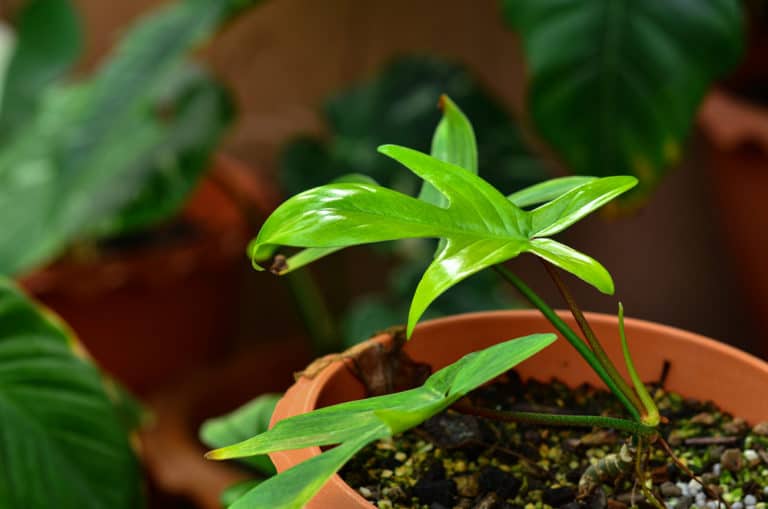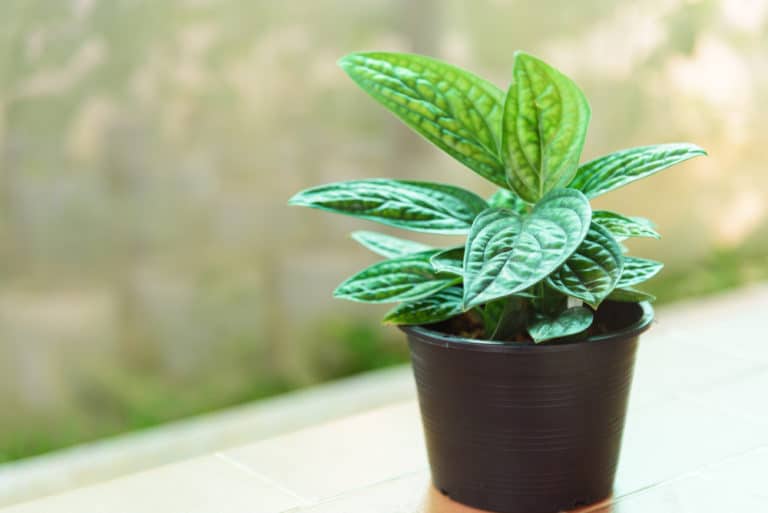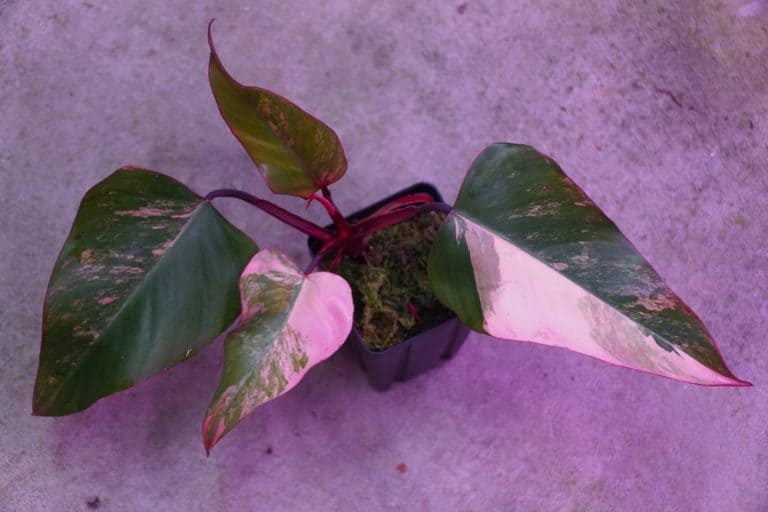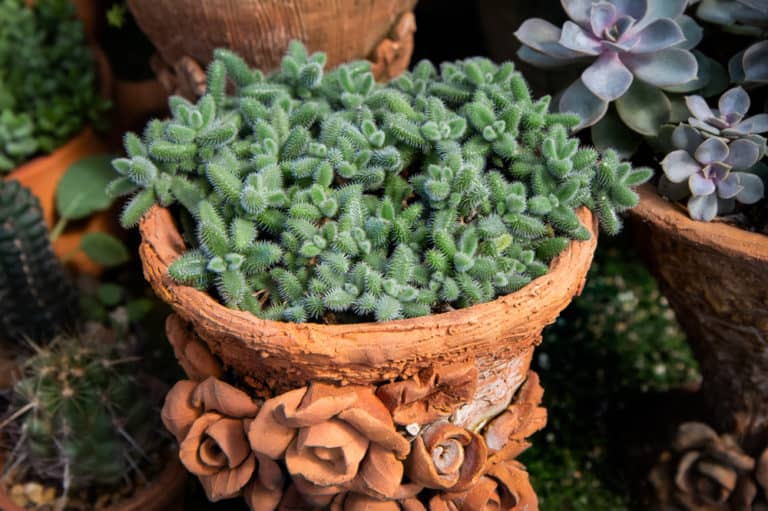Ficus Elastica ‘Tineke’ Care Guide (2024)
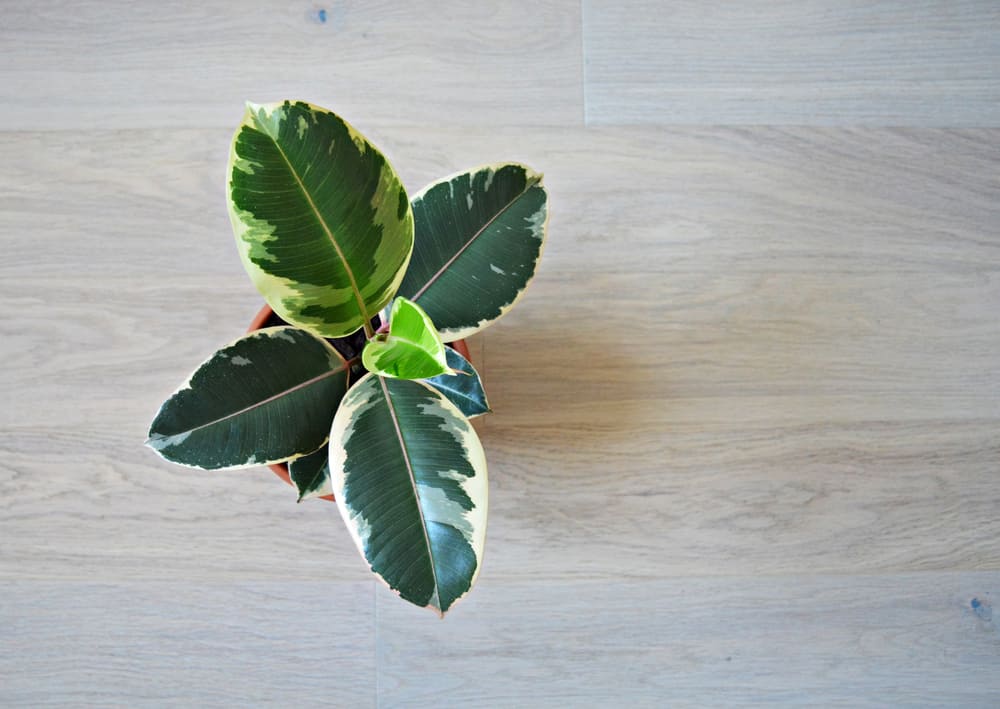
Ficus Elastica Tineke is a relatively new hybrid of the rubber tree, with beautifully variegated leaves.
The Tineke Rubber Tree is a great choice for growing as an indoor tropical plant. Not only is it very ornamental, but it’s useful as well, as it purifies the air for a healthier indoor environment.
| Scientific Name | Ficus elastica ‘Tineke’ |
| Common Name | Ficus Tineke, Variegated Rubber Plant |
| Light | Bright indirect sunlight |
| Watering | Water if the top inch of soil is dry |
| Temperature | 60 to 95°F (18 to 35°C). |
| Hardiness Zone | 10 to 12 |
| Humidity | 50 to 75% |
| Soil Type | Rich, quick-draining, loamy |
| Soil pH | 6.0 to 6.5 (mildly acidic) |
| Fertilizing | A balanced feed once a month in spring and summer |
| Repotting | Every 2 years |
| Pruning | Beginning of the growing season |
| Propagation | Root in water or soil |
| Toxicity | Toxic to humans and pets |
| Mature Size | 2 to 10 feet as a houseplant |
| Bloom Time | Does not bloom indoors |
What’s Unique About Ficus Tineke?
The Ficus Tineke plant has never grown in the wild, as it is a recent hybrid of the rubber tree. Ficus elastica is native to Southeast Asia, with a range from the Himalayas to Sumatra and Java.
Ficus Tineke plants have beautifully variegated foliage. The pattern looks like impressionist brushstrokes of pale green, cream, and pink on its large, glossy dark green leaves.
Growing Ficus Tineke is not a difficult undertaking, even for a beginner gardener.
As well as looking good, Ficus Tineke also filters not just chemicals like formaldehyde and benzene, but also dangerous molds and bacteria from your indoor air.
Ficus Tineke Care
The rubber tree originates in the rainforests of Southeast Asia, and so is acclimated to the conditions that it evolved in there.
You will be able to provide the best Ficus Tineke plant care if you understand those conditions.
Tineke Rubber Tree care can be summarized down to keep it moist, keep it warm, and keep it out of the bright sun.
Light
In the rainforests, rubber trees start their life growing under the tree canopy that filters the harsh rays of the tropical sun.
While mature rubber trees are very tall, and part of that canopy, you will be growing a juvenile Ficus Tineke in your home.
Thus, Ficus Tineke light requirements are for bright but indirect light, or between 10,000 to 20,000 lux.
Exposure to full sun will fade the variegation or damage the leaves.
Natural light should be enough to meet Tineke Rubber Tree light needs.
You can put your Ficus Tineke close to an east or north window, or several feet away from the window in a south or west facing room.
Watering
In the rainforests, rubber trees grow in soil which stays moist at all times.
For your own Ficus Tineke watering, it’s important to maintain consistently moist soil while not letting the pot sit in water, which will drown the roots.
Water Tineke Rubber Tree whenever the first inch or so of the soil has dried out.
Gently water the soil surface until it has absorbed all it can and excess water runs out the bottom.
Ficus Tineke’s watering needs are best met with distilled water or rainwater.
If you must use tap water, let it sit overnight to reach room temperature and dissipate the chemicals such as fluoride.
Temperature
Although rubber trees grow in the hottest band of the tropics, Ficus Tineke will actually grow happily at lower temperatures.
The Ficus Tineke temperature range is 60 to 95°F (18 to 35°C).
You are unlikely to be able to deliver the hottest acceptable temperature for Tineke Rubber Tree. Still, any modern heated home or office will have sufficiently high temperatures for good Ficus Tineke growth.
However, once you get below that, Ficus Tineke has limited temperature tolerance. At 50°F (10°C), it will go into dormancy and new growth will be stalled.
Finally, Ficus Tineke has no frost hardiness. If you move your potted plant outdoors in the hot summer months, bring it in long before freezing temperatures return.
Humidity
In the tropical rainforest, rubber trees are used to high humidity levels. Thus, the ideal humidity for Tineke Rubber Tree is 50 to 75%.
For humans and buildings, that is not a healthy environment, but it is possible to accommodate Ficus Tineke humidity requirements.
You can probably keep your Ficus Tineke happy at a humidity level of 40%, but anything below that will lead to crispy edges on the leaves.
While daily misting with distilled water can work, it can become a big task as your Ficus Tineke grows in size.
A pebble tray filled with water will add some moisture to the air.
However, the most effective solution is to buy a small humidifier to boost humidity levels for all your tropical plants.
Soil
Ficus Tineke soil should be able to retain moisture, while at the same time giving the roots some air to breathe.
The best pH level for Tineke Rubber Tree is 6.0 to 6.5, or mildly acidic.
A standard houseplant potting soil will be an adequate soil mix, but it’s also possible to make your own custom soil for Tineke Rubber Tree.
Start with regular potting soil, and add equal parts of peat moss and perlite.
You can also just use peat moss, perlite, and pine bark for a soilless potting mix that will retain moisture but maintain an open structure.
Fertilizer
It is not essential to use fertilizer for Tineke Rubber Tree, as it will grow fairly well even without extra nutrients.
However, if you want the biggest and most colorful foliage, you should use Ficus Tineke fertilizer.
If you added some well-rotted compost or slow-release granules when you potted your Ficus Tineke, that should be sufficient to keep it thriving.
Otherwise, you can use a standard liquid fertilizer with a 10-10-10 fertilizer ratio on a monthly basis during spring and summer.
Dilute it to half the recommended strength and apply to the soil surface towards the outer edge of the pot. Do this right after you’ve watered your Ficus Tineke.
Potting & Repotting
Ficus Tineke repotting should be done every couple of years.
However, instead of sticking to a strict schedule, keep an eye on a few key indicators that it’s time for repotting Tineke Rubber Tree.
When the soil seems to be disappearing in a tangle of roots, or roots are growing out the bottom of the pot, it has become root bound.
When choosing a new pot, only go up one pot size, or an inch or 2 in diameter. Too large a new pot will set back your Ficus Tineke’s growth. Make sure it’s got good drainage.
Always use fresh potting soil.
Pruning
Ficus Tineke pruning can be done to create a fuller, bushier shape rather than a tall, slender tree. Cut just above a node on the stem, and new leaves will soon start growing.
You can also trim off any aerial roots that form if you don’t like how they look.
It’s best to do any pruning in spring and summer, during its active growing season.
When cutting Tineke Rubber Tree, avoid contact with the milky sap. It contains latex, which can cause a rash.
Wear gloves, and if any gets on your skin, rinse it off as soon as possible.
Propagation
The easiest method of Ficus Tineke propagation is by rooting stem cuttings, although you can also do it by air layering.
To propagate Tineke Rubber Tree, start by taking young stems about 12 inches long. Each stem cutting should have at least a couple of leaves.
Cut just below a node, as that is where the new roots will form.
Either place the stems in a jar of water or set them in moist soil. Cover with a plastic bag to conserve humidity, leaving it open a bit to let the cuttings breathe.
Within about 6 weeks, you should have new small plants with roots to plant out in their own pots.
Also, make sure to check out our in-depth Ficus elastica ruby plant care guide.
Common Problems of Ficus Tineke
No plant is completely foolproof, but you do not have to worry about many Ficus Tineke problems.
Most problems with Tineke Rubber Tree can be prevented by paying close attention to its preferred growing conditions.
Regular inspection of the leaves will usually alert you to any problems before they get out of hand.
Pests
Ficus Tineke pests can be prevented with regular maintenance.
Wipe down the leaves of your Ficus Tineke once a month with a cloth that’s dampened with insecticidal soap and neem oil. This will keep bugs away.
However, if you already have pests on your Tineke Rubber Tree, it’s not too hard to identify and get rid of them.
Spider mites spin sticky webs and leave small yellow bumps on the leaves. Wash down the whole plant in the shower.
Aphids are small green insects on the stems and underside of the leaves. Use a hand vacuum to eliminate them.
Mealybugs look like cotton puffs on the underside of leaves. Wipe them off with rubbing alcohol.
Scale are usually on the stems and look like little brown bumps. Scrape them off.
Diseases
Ficus Tineke diseases are usually the result of too much water. Make sure that you are not overwatering your Tineke Rubber Tree.
Anthracnose is a fungus that causes reddish or light brown lesions on the leaves. There is often a yellow halo around the spots.
Bacterial Leaf Spot causes wet-looking spots near the edges of the leaves. They spread and grow together and can quickly kill a plant if not treated.
Root Rot causes yellowing leaves and mushy stems. Upon examination, you will see that some of the roots have turned black and smell bad.
For all of these, move your Ficus Tineke away from other plants, and cut out all infected parts. Replant in fresh soil and consider using a fungicide to prevent future outbreaks.
Growing Problems
Some growing problems are simply a consequence of not paying close enough attention to your Ficus Tineke’s needs. Your sick plant might just need to be moved to a better location to thrive.
Dropping leaves may indicate that your Ficus Tineke is not in a warm enough spot. Check to make sure it’s not in a draft or too close to an air conditioning vent.
Brown spots on leaves can mean that your Ficus Tineke needs higher humidity.
If your Ficus Tineke leaves are turning all green instead of displaying their usual range of colors, it needs more light. Move it to a brighter spot while still keeping it out of the full sun.
Toxicity of Ficus Tineke
Tineke Rubber Tree is toxic to humans and animals because of the latex in the sap.
While it is generally considered to have low toxicity, some people have a latex allergy that can be life-threatening.
Animals can suffer severe gastrointestinal problems and possible organ damage.
Care should be taken in growing Ficus Tineke in a home with children or animals.
For Humans
On the whole, the latex in the sap of Ficus Tineke is rated as the lowest level of toxicity for humans.
Children are also very unlikely to try any more than the tiniest bites since the taste is terrible.
However, if the sap gets on your skin, you may develop a rash, so rinse it off as soon as possible.
The real concern with latex is that some people have a severe allergy to latex that can cause a life-threatening anaphylactic reaction.
If someone who has been exposed to the sap starts wheezing or has trouble breathing, take them to the emergency room immediately.
For Pets
Most common pets, including cats, dogs, rabbits, and birds, can have a serious reaction to ingesting latex.
Symptoms of latex poisoning can include vomiting, diarrhea, drooling and lack of coordination.
Animals can also appear depressed.
Do not try to assess the level of poisoning on your own, but take your pet to the veterinarian immediately.
You might be able to set up an attractive trellis as a fence at ground level to keep your pets from being able to get at your Ficus Tineke.
However, if your cats are determined climbers, you may simply have to decide to keep less toxic plants in the same household as pets.
Ficus Tineke Appearance
Ficus Tineke is a big plant with gorgeous leaves. Just for the Ficus Tineke appearance it’s worth keeping in your indoor garden.
Watching it grow over the years can give you a real sense of accomplishment as a plant parent.
While it is extremely unlikely to flower for you, the leaves alone are more than attractive enough to make up for that.
Foliage
In a word, the foliage of Ficus Tineke is beautiful.
On every leaf of this plant, you will see broad brushstrokes of cream, pale green, and pink against a dark green background.
They have a glossy surface and leathery texture.
Leaves grow to 12 inches long and 5 inches across. New leaves emerge from the top of the center stem, and the older leaves at the bottom gradually die and fall off, revealing the stem.
Leaves remain on the plant for a long time, so to keep them looking their best they should be wiped down monthly to remove dust and grime.
Flowering
Ficus Tineke flowering very rarely happens on plants grown inside in temperate climates.
The only real chance you have to see a Ficus Tineke blooming is if you can plant it outside in a tropical region.
However, since the flowers are insignificant white blossoms with hardly any scent, it’s not worth making the effort to get your Ficus Tineke to bloom.
Some people mistake the green and pink sheath of an emerging leaf for a flower. They’re pretty good looking all on their own.
On the whole, the variegated leaves of your Ficus Tineke provide more than enough long-lived color.
Size and Growth
There’s a big difference in the size of Ficus Tineke when grown as a houseplant as opposed to outdoors.
In a tropical region rubber trees can reach heights between 50 and 100 feet.
Indoors, you can expect a much more reasonable top height of 10 feet, and many top out at 5 to 6 feet.
Ficus Tineke’s growth rate is fast, with the potential for up to 24 inches a growing season. New leaves appear every month or so.
You can prune your Ficus Tineke to develop a shorter, bushier look, or let it grow up into a slender tree.
Ficus Tineke Fragrance
You are unlikely to ever detect any Ficus Tineke fragrance. The rare Tineke Rubber Tree flowers have little scent even if they do appear, and there is no fragrance in the foliage.
However, that’s not entirely a bad thing. People with a sensitivity to fragrances will prefer a houseplant that has no smell, pleasant or otherwise.
In fact, many public institutions, including schools and nursing homes, actually prohibit plants with strong fragrances because of these sensitivities.
The leaves of Ficus Tineke are so beautiful that the lack of fragrance shouldn’t be a deal-breaker.
However, you could use some essential oils like lemongrass or geranium in your monthly leaf-cleaning solution to impart a delicate scent.
Suggested Uses for Ficus Tineke
Since Ficus Tineke not only looks good but is also an excellent air purifier, it’s worth trying to find room for this large tropical plant indoors.
In a room with a cathedral ceiling, you can encourage it to grow as high as it can.
Grow it alone as an architectural piece, or as a backdrop to an indoor tropical garden. The variegated leaves of Ficus Tineke, with their watercolor shadings, will be a stand-out wherever it is placed.
Set in a shaded corner on a patio or deck, it will create an instant tropical atmosphere in the hot summer months.
FAQ
What is Ficus Tineke?
Ficus Tineke is a recent hybrid of the Indian rubber tree, a native of Southeast Asia. It is primarily grown as a tropical potted houseplant.
How to identify Ficus Tineke?
Ficus Tineke has large, glossy green leaves with cream, pale green, and pink variegation. It starts as a clump of leaves and then grows into a small tree.
How to care for Ficus Tineke?
Ficus Tineke needs to be kept in a warm, humid environment out of the full sun, with soil that is kept consistently moist but well-drained.
How to grow Ficus Tineke indoors?
Ficus Tineke is usually grown indoors as a potted plant, and should be placed in bright, indirect light in a warm room with high humidity.
How to grow Ficus Tineke outdoors?
Ficus Tineke can only be grown outdoors in the ground year-round in tropical climates, but can be moved outside in hot summer weather in temperate zones.
How fast does Ficus Tineke grow?
Ficus Tineke can grow as much as 2 feet in a typical growing season, taking up to 5 years to reach a full height of 10 feet.
How tall does Ficus Tineke grow?
Ficus Tineke can grow as tall as 50 to 100 feet when grown outdoors, but will reach a full height of 8 to 10 feet as a potted house plant.
How to make Ficus Tineke grow faster?
Ficus Tineke will grow the fastest in hot temperatures and high humidity, with regular watering to maintain moist soil and regular fertilizing for healthy growth.
How to stake Ficus Tineke?
Ficus Tineke naturally develops a thick, sturdy stem, so it does not require any staking. To prevent it developing a lean towards the brightest light, rotate its pot regularly.
How to pot Ficus Tineke?
Ficus Tineke should be potted in a plastic or glazed pot to conserve soil moisture, with good drainage so the roots will not be sitting in water.
How to revive Ficus Tineke?
If your Ficus Tineke is drooping and the soil has dried out, put the whole pot into enough water to cover it, and let the soil absorb the water evenly.
Why is my Ficus Tineke dying?
Your Ficus Tineke may have a bacterial or fungal disease caused by overwatering or letting the foliage stay wet. Cut out affected parts and repot in fresh soil.
Why is my Ficus Tineke drooping?
If your Ficus Tineke is drooping, it may be too dry or too wet. Either give it a thorough watering, or repot it in fresh, well-draining soil.
How cold can Ficus Tineke tolerate?
Ficus Tineke will be killed by temperatures below freezing, and anything lower than 50°F (10°C) will slow down or stop its new growth and damage the plant.
How to get rid of pests on Ficus Tineke?
Ficus Tineke pests can be eliminated or prevented by regularly spraying or wiping down the leaves and stems with an insecticidal soap or neem oil solution.
Is Ficus Tineke toxic to cats?
Yes, Ficus Tineke is toxic to cats. If your cat has eaten some of the foliage and has vomiting or diarrhea, or seems depressed, take it to the veterinarian immediately.
Is Ficus Tineke toxic to dogs?
Yes, Ficus Tineke is toxic to dogs. If your dog is drooling, stumbling, vomiting or has diarrhea, you should take him to the vet as soon as possible.
Is Ficus Tineke toxic to children?
Ficus Tineke is only mildly toxic to children, but an allergic reaction to the latex could trigger an anaphylactic reaction. If they start wheezing, take them to the emergency room.
Is Ficus Tineke toxic to humans?
Ficus Tineke is not very toxic to humans, but you could have a rash from getting the sap on your skin, or an anaphylactic reaction in the case of a latex allergy.
Does Ficus Tineke have a scent?
Ficus Tineke leaves are fragrance-free, and the rarely-seen flowers have hardly any scent. This makes Ficus Tineke ideal in settings where fragrant plants are not allowed.


